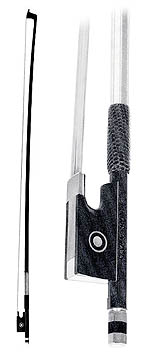
| Opus 37 - Violin Bow |
|
|
While its exact origin is uncertain, the bow appears to have come from central Asia. A tenth-century treatise by a Baghdad theoretician and scholar named Al-Faradi on the rebab (Arab violin) proves that the bow already existed by then. Moreover, around this time the bow was introduced into Europe from the Arab and Byzantine countries. The modern bow, developed in the mid-eighteenth century, differed from its predecessors in its slightly concave curve, making it stronger and more precise. Around 1780, the Parisian bow maker François Tourte (1747-1835) developed the bow which, except for minor variations, is still used today. The hair of the bow is horsehair as many as two hundred strands on a modern bow. To ensure that the horsehairs adhere properly to the strings, they are rubbed with a solid resin called colophane or arcanson, which is obtained by distilling turpentine. The bow featured here has an octagonal stick, decorated with silver thread. The ebony nut is ornamented with mother-of-pearl and silver, and the head plate is made of silver. Joseph Kun learned instrument making in his native Czechoslovakia. After settling in Canada in 1968, he earned an international reputation for his bow making. A luthier as well as a bow maker, he crafted violins, violas and violoncellos, and was also well known for his repair and restoration work. Guarneris, Stradivaris and other valuable instruments were often sent to his workshop for delicate repairs. Joseph Kun was a member of the American Federation of Violin and Bow Makers. His bows have won numerous awards in international bow-making competitions. Joseph Kun's label |
 |


